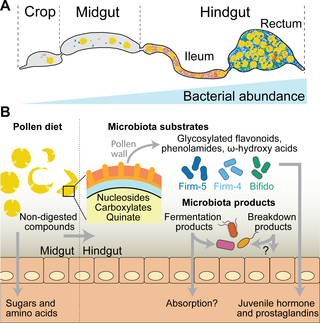PLOS Biology ( IF 9.8 ) Pub Date : 2017-12-12 , DOI: 10.1371/journal.pbio.2003467 Lucie Kešnerová , Ruben A. T. Mars , Kirsten M. Ellegaard , Michaël Troilo , Uwe Sauer , Philipp Engel

|
It is presently unclear how much individual community members contribute to the overall metabolic output of a gut microbiota. To address this question, we used the honey bee, which harbors a relatively simple and remarkably conserved gut microbiota with striking parallels to the mammalian system and importance for bee health. Using untargeted metabolomics, we profiled metabolic changes in gnotobiotic bees that were colonized with the complete microbiota reconstituted from cultured strains. We then determined the contribution of individual community members in mono-colonized bees and recapitulated our findings using in vitro cultures. Our results show that the honey bee gut microbiota utilizes a wide range of pollen-derived substrates, including flavonoids and outer pollen wall components, suggesting a key role for degradation of recalcitrant secondary plant metabolites and pollen digestion. In turn, multiple species were responsible for the accumulation of organic acids and aromatic compound degradation intermediates. Moreover, a specific gut symbiont, Bifidobacterium asteroides, stimulated the production of host hormones known to impact bee development. While we found evidence for cross-feeding interactions, approximately 80% of the identified metabolic changes were also observed in mono-colonized bees, with Lactobacilli being responsible for the largest share of the metabolic output. These results show that, despite prolonged evolutionary associations, honey bee gut bacteria can independently establish and metabolize a wide range of compounds in the gut. Our study reveals diverse bacterial functions that are likely to contribute to bee health and provide fundamental insights into how metabolic activities are partitioned within gut communities.
中文翻译:

解开蜜蜂肠道中细菌的代谢功能
目前尚不清楚有多少个体社区成员对肠道菌群的整体代谢输出有贡献。为了解决这个问题,我们使用了蜜蜂,它具有相对简单且非常保守的肠道菌群,与哺乳动物系统非常相似,并且对蜜蜂健康具有重要意义。使用非靶向的代谢组学,我们分析了由培养菌株重构的完整微生物群定殖的gnotobiotic蜜蜂的代谢变化。然后,我们确定了单个群体蜜蜂中单个社区成员的贡献,并使用体外培养概括了我们的发现。我们的结果表明,蜜蜂肠道菌群利用了多种花粉来源的底物,包括类黄酮和外部花粉壁成分,提示了难降解的次生植物代谢产物降解和花粉消化的关键作用。反过来,多种物质负责有机酸和芳族化合物降解中间体的积累。而且,是特定的肠道共生体,双歧杆菌小行星刺激已知会影响蜜蜂发育的宿主激素的产生。尽管我们发现了交叉喂养相互作用的证据,但在单殖民地蜜蜂中也观察到约80%的已识别代谢变化,其中乳酸杆菌占代谢输出的最大份额。这些结果表明,尽管进化联系延长,但蜜蜂肠道细菌仍可以在肠道中独立建立和代谢多种化合物。我们的研究揭示了可能有助于蜜蜂健康的多种细菌功能,并提供了有关肠道内代谢活动如何分配的基本见解。



























 京公网安备 11010802027423号
京公网安备 11010802027423号